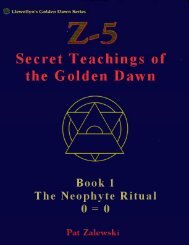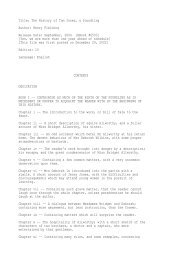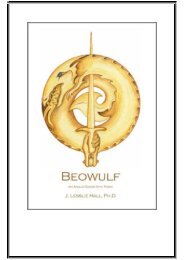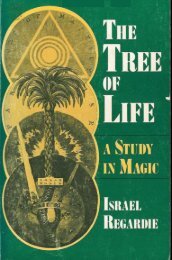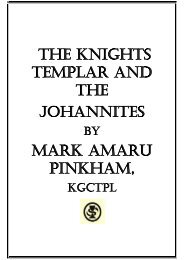Click to download PDF version: 3.87MB - Global Grey
Click to download PDF version: 3.87MB - Global Grey
Click to download PDF version: 3.87MB - Global Grey
You also want an ePaper? Increase the reach of your titles
YUMPU automatically turns print PDFs into web optimized ePapers that Google loves.
175 At the Back of the Black Man's Mind By R. E. Dennett<br />
the month or season of love or spring. It is called IKHURE, and is the time of drizzling<br />
rains, just before the rainy season. This month, however, instead of representing the<br />
first month at the beginning of the dry season, is in the place of the sixth month of the<br />
Bavili.<br />
The next period is EHAW, and includes the seasons IHEDU, two months of which are the<br />
<strong>to</strong>rnado months, and IHEMA, two months of heavy rains. EHAW is the cus<strong>to</strong>m of giving<br />
food <strong>to</strong> a stranger on his arrival in a <strong>to</strong>wn.<br />
The next period is named IGWE, and it includes the seasons IGWE, two months,<br />
including the little dry season and heavy rain, and AGWE, one <strong>to</strong>rnado month and one<br />
month of rest and quiet. IGWE (or IGBE or IWE = weight also 10) signifies the care and<br />
dress of children, and is the season of harvest. It is worthy of note that the Bini connect<br />
the idea of weight with harvest.<br />
The period IHEUKU is that which contains the seasons AHISHUKU and IHEUKU, the four<br />
months forming their dry season.<br />
It is said that the Bini have no names for their months, and this in a sense is true. But<br />
they number them, and so the numbers are really their names. If we wish <strong>to</strong> know the<br />
meanings of the names of their months we must get at the signification of their<br />
numerals.<br />
1. Let us begin with the first month of their dry season, when, having reaped their<br />
harvest of yams, the people say they "rest and chop." This is the second month in the<br />
season AGWE. The word for one is ÔWU, which in the form Owu means death, or, as we<br />
might put it, the beginning and end of all things. This agrees with the time and idea<br />
contained in the month of MAWALALA in the Kongo.<br />
2. The next month, the first in the AHISHUKU season, the Bini are busy cutting down<br />
woods and forests for the purpose of making their farms. This action they call IFIE.<br />
IFA is literally that which is scraped off and is also the name of the palm nut god of the<br />
Yoruba. The verb FA is <strong>to</strong> clean or scrape off.<br />
The letters F, H, and Y, are interchangeable thus, HA is <strong>to</strong> scrape, UHE the Bini for IFE,<br />
and the Bina palm tree river spirit, taking the place of the Yoruba IFA is OVIA. O is a<br />
royal title short for OGIE; IA is the lengthened form of A, so that OVIA is really a<br />
lengthened form of IFA.<br />
E as a prefix gives the verb following it a substantive form; thus EFA or EVA would mean<br />
a scraping. This idea of scraping off is connected with the idea of creation both in Xivili<br />
and Bini. The Bini use the word EVA as the numeral 2; EVA is therefore connected both<br />
with the river spirit OVIA and with ideas of creation.<br />
3. The third month the people begin <strong>to</strong> burn what they can of the felled trees, and this<br />
act they call EGBAW.<br />
www.globalgrey.co.uk



